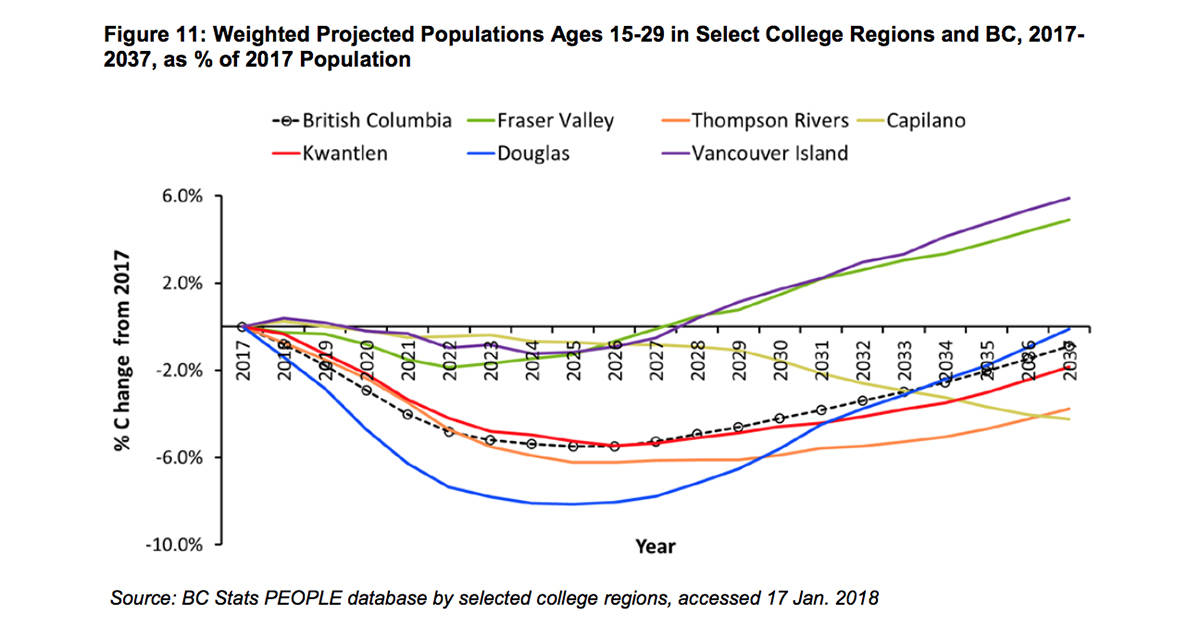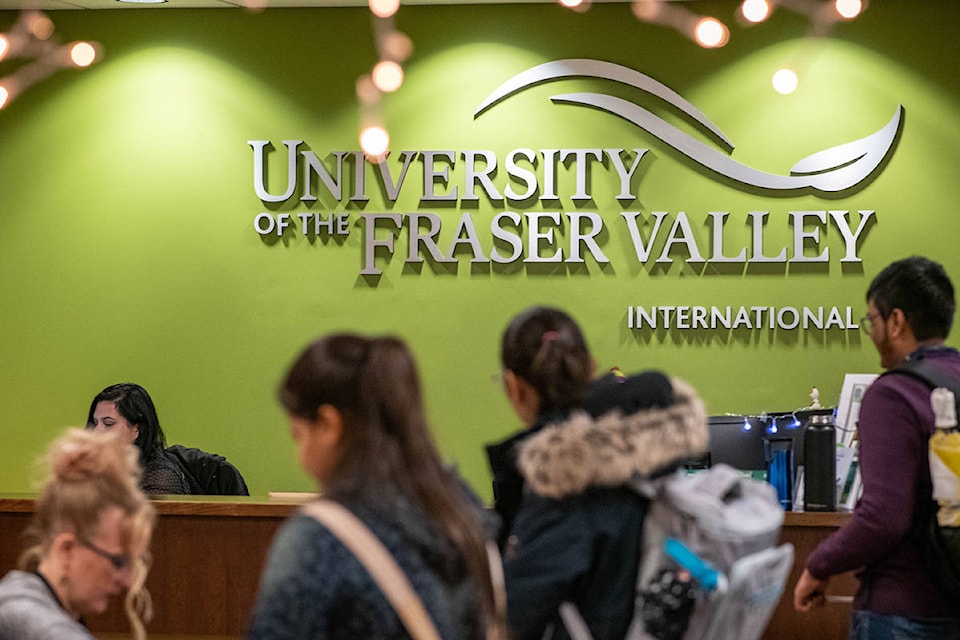Abbotsford’s University of the Fraser Valley campus remains well over capacity even as fewer local students are walking through its halls.
And while steadily increasing international student enrolment has kept UFV bustling in recent years, increased reliance on their tuition fees presents its own risk, according to experts and the university’s most-recent accountability report.
Domestic enrolment at UFV has slowly but consistently decreased over the last half-decade, from just under 7,300 full-time equivalent students in 2012, to about 7,000 in the last scholastic year.
That’s not unique in the province, with fewer college-age residents translating into decreased enrolment at most universities. That trend is expected to reverse itself in a few years, with the number of older teenagers expected to push domestic enrolment in UFV back up around 2022. That is earlier than in most other regions. And that could force some tough decisions.
The Abbotsford campus’s utilization rate is already at 112 per cent, with booming international student enrolment more than making up for the recent decline in local students. International enrolment has risen by 87 per cent since 2012.
International students play a positive role in creating a vibrant university campus, increasing links between the Fraser Valley and the broader world, and giving local students the tools needed to succeed in a globalizing world, according to UFV’s “internationalization” strategy. Those students also pay more than triple the rate of domestic students and cover the full cost of their educations.
But with revenue from international students more than doubling since 2010, increasing reliance on that money also brings risks.
The accountability report notes that economic events, foreign policy shift or global catastrophe could reduce international enrolment and hit the university’s budget. The fact that students come from a limited number of regions “increases the potential impact of international enrolment decline,” the report warns. Last year, students from India and China accounted for more than 80 per cent of the international students attending UFV.
(Increasing tensions between China and Canada could have less of an impact on international enrolment at UFV today than a couple years ago. Over the last two years, India has surpassed China as the largest contributor of students. More than 1,000 Indian students attended UFV in Canada last year, compared to 359 Chinese students. That Chinese figure was down 20 per cent in 2017/18.)
But that doesn’t change the fact that UFV – like many other universities – has become increasingly dependent on foreign students as a revenue generator.
Last year in an article for Policy Options magazine, post-secondary policy consultant Alex Usher argued that tuition from international students has helped fill a funding gap in Canadian universities. Sagging domestic enrolment numbers has made that possible by opening up space for such students.
“That demographic shift won’t last forever,” Usher warned. “Early next decade, the number of 18-year-olds in western Canada will start to rise again … at which point institutions are going to be forced to make difficult choices between their lucrative international students and their domestic constituencies.”
If both groups of students keep growing, taxpayer-funded governments will have to give universities more money to build more classrooms. And if international students are pushed aside, the revenue they generate will also have to be found elsewhere, Usher notes. That would need to come either from increased government funding, or through tuition and fee hikes.
A spokesperson from the Ministry of Advanced Education noted that universities “are expected to enroll international students on the basis that they do not displace a Canadian citizen or permanent resident from a space funded by the provincial government.”
The complexity of the issue was spelled out by a 2017 American study that found that foreign students may actually increase domestic enrolment by keeping costs down for newer students.
UFV has been asking for more money for years. At its Abbotsford campus, there is a space crunch that is already compromising a valuable feature of university life, the accountability report says.
“Perhaps most importantly, a common feature of university life is informal meetings and discussions of students and faculty – among themselves or with each other,” the report says, in advocating for more space. “These interactions typically happen in an empty classroom. On the Abbotsford campus, none of these empty classrooms exist.”
The university has a relatively simple solution to the space crunch and the eventual rebound of domestic enrolment: new buildings.
RELATED: UFV buys Finnegan’s building for nearly $10 million
RELATED: UFV seeks funding for $30 million high-tech building
For several years now, UFV’s capital plan has included a proposed $40 million Digital Hub building that would provide more spaces for high-tech learning. Its most recent plan has also pitched the expansion of the campus’s Building C that would provide more than 10,000 square feet of new instructional space.
But so far, the provincial money needed for those projects has failed to come through. With space at a minimum, and those projects still up in the air, the university bought the former home of Finnegan’s Pub in the fall for nearly $10 million. The aim was to convert the building for teaching and office space made particularly urgent because of renovations at two existing UFV buildings.
UFV did not respond to requests for comment.
@ty_olsen
tolsen@abbynews.com
Like us on Facebook and follow us on Twitter.

